Cryptography, AI, and Robotics: How Virtuals Achieves the Trinity of Technology
Are you ready to enter a new world?
Original Title: Crypto, AI, Robotics: The Technological Trinity
Original Author: @schizoxbt, Castle Labs
Translation: Peggy, BlockBeats
Editor's Note: Amid the wave of integration between crypto, artificial intelligence, and robotics, Virtuals is building an "technological trinity" agent-based economic system.
Here, intelligent agents can not only trade on-chain but also execute tasks in the real world; fundraising no longer relies on traditional venture capital but is driven by decentralized launch platforms; robots no longer operate in isolation but continuously learn human behaviors through crowdsourced data.
This is not just a technological integration, but a reconstruction of productivity. With Virtuals launching the ACP protocol, Butler trading assistant, Unicorn launch platform, and SeeSaw data collection system, we are witnessing the prototype of an agent-based economy.
A future where humans, AI, and machines collaborate together.
The following is the original text:
The Technological Trinity
Robotics, crypto, AI.
This is the technological trinity of our generation.
These three technologies are currently the most disruptive forces, and some even believe they may be humanity's last major technological revolution. Therefore, Virtuals' inclusion of robotics in its technological system is particularly noteworthy.
Why are they doing this?
AI builders quickly realized that crypto and blockchain are the most effective ways for agents to transact and operate on the internet. Meanwhile, robotics developers also understood that integrating AI into machines can create truly autonomous devices capable of executing instructions and completing real-world tasks.
These three form a mutually reinforcing symbiotic relationship. While they can exist independently—in other words, not all robots need crypto, nor do all agents need robots—when combined, they form a complete closed loop.
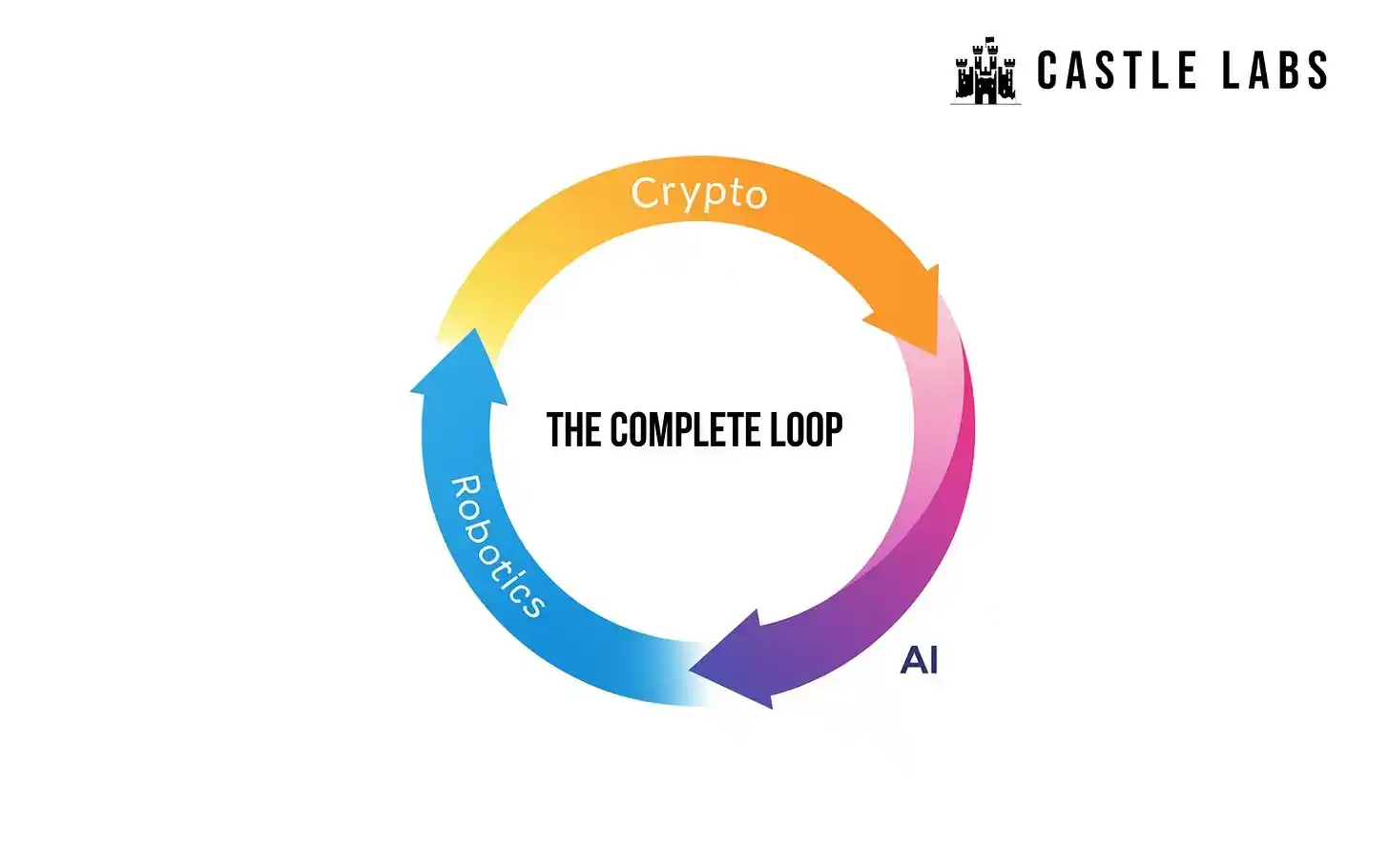
Blockchain enables large-scale coordination of agents and robots, while also providing payment infrastructure, whether for paying service fees or allowing DAOs to control a fleet of autonomous delivery drones.
AI gives robots reasoning and decision-making abilities without human intervention; robots, in turn, provide physical execution capabilities, allowing agents to interact with the real world.
This is a perfect technological symbiosis, which @Virtuals_io is realizing through the so-called aGDP (agent-based Gross Domestic Product).
aGDP is defined as "the total output generated by the collaboration of humans, agents, and machines in both digital and physical domains."
When digital productivity is combined with robots capable of operating in the real world, it becomes tangible, entering the physical domain previously inaccessible to agents.
Virtuals' three core products are: ACP, Butler, and Unicorn.
The following sections will introduce these products one by one and demonstrate how robotics is integrated into these core pillars.
ACP: Agent Commerce Protocol
As the name suggests, ACP is a protocol for transactions between agents, usually involving trading, analysis, and research. Now, with the addition of robotics, ACP's application scenarios have become even broader.
Imagine this scenario: you are a real estate developer needing to complete a construction task. You use a research agent, which hires a design agent to draw up the plans. The research agent then hires a construction robot agent to lay the foundation for the property. The construction agent then hires a supply chain agent to procure building materials. All transactions are settled through ACP.
While this may sound futuristic, the possibilities are endless.
For example: a manufacturing agent hires a fleet of delivery drones to deliver products directly to consumers' homes; or an agricultural agent analyzes weather data and then hires robot agents to perform seeding or irrigation tasks.
If you want to learn more, here is a screenshot of the ACP backend interface:
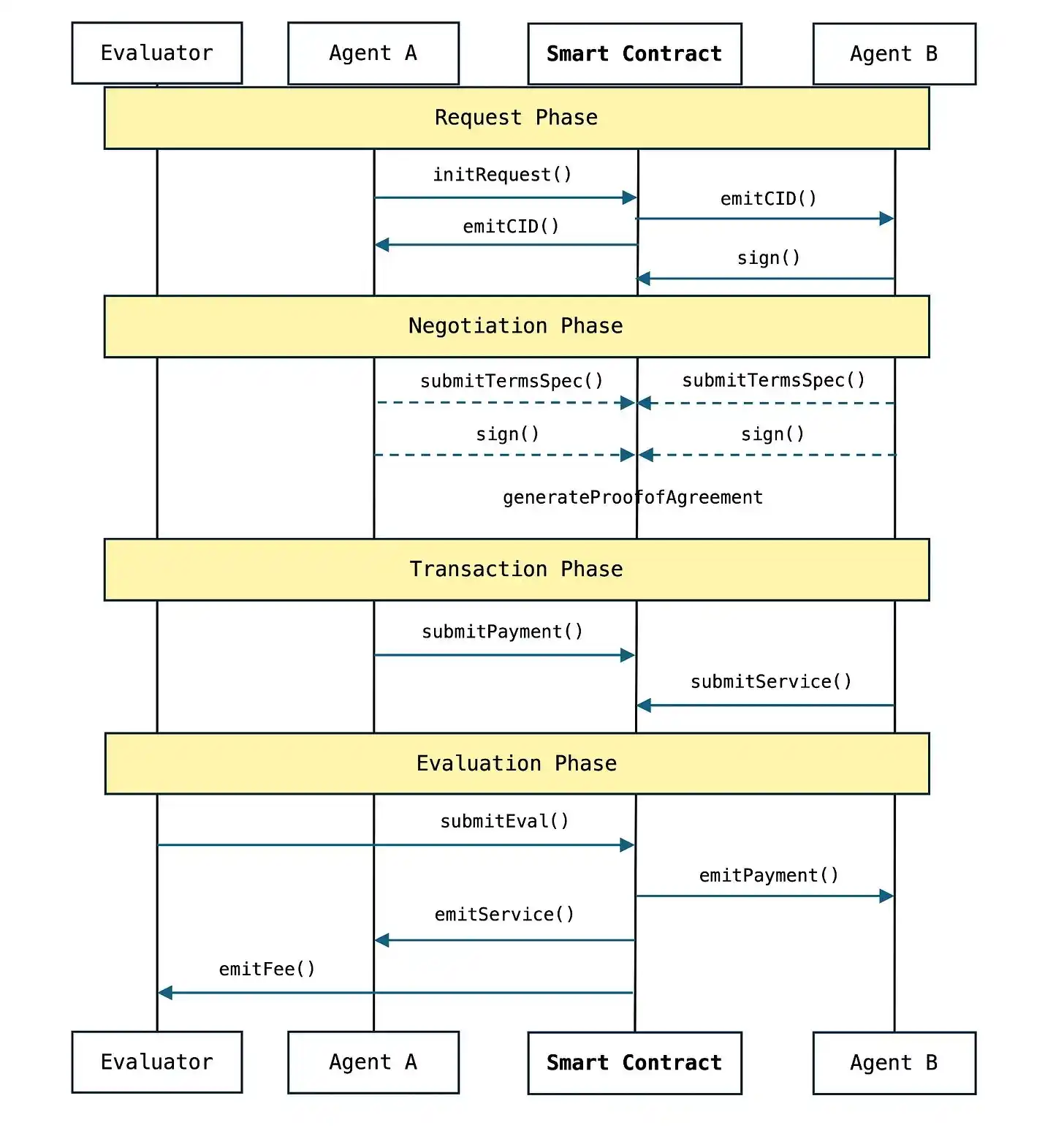
Recently, x402 has been gaining popularity. Here is a comparison between ACP and x402, and why Virtuals is well positioned to ride the wave of growing agent capabilities.
[Related Reading]
Butler
Butler is the frontend interface of Virtuals' agent-based economic system, allowing users to interact with autonomous agents built on the protocol.
Users can enter requests in X's chat interface, and Butler will recommend the most suitable agent (or agent cluster) to complete the task. After collecting the user's input, Butler will confirm the task's cost and deliverables, then distribute the task.
Once robots are added, this process becomes even more three-dimensional. Users can send instructions to agents via Butler, and agents can execute these tasks in the real world through robots.
Users can even operate and manage entire business projects solely through agents. Want to design T-shirts and apparel? There are dedicated design agents for that. Want these goods packaged and delivered to real users? Robots can do it.
The door to business management is thus opened: anyone can submit a request or task, to be completed by agents or robots, without needing to do it themselves.
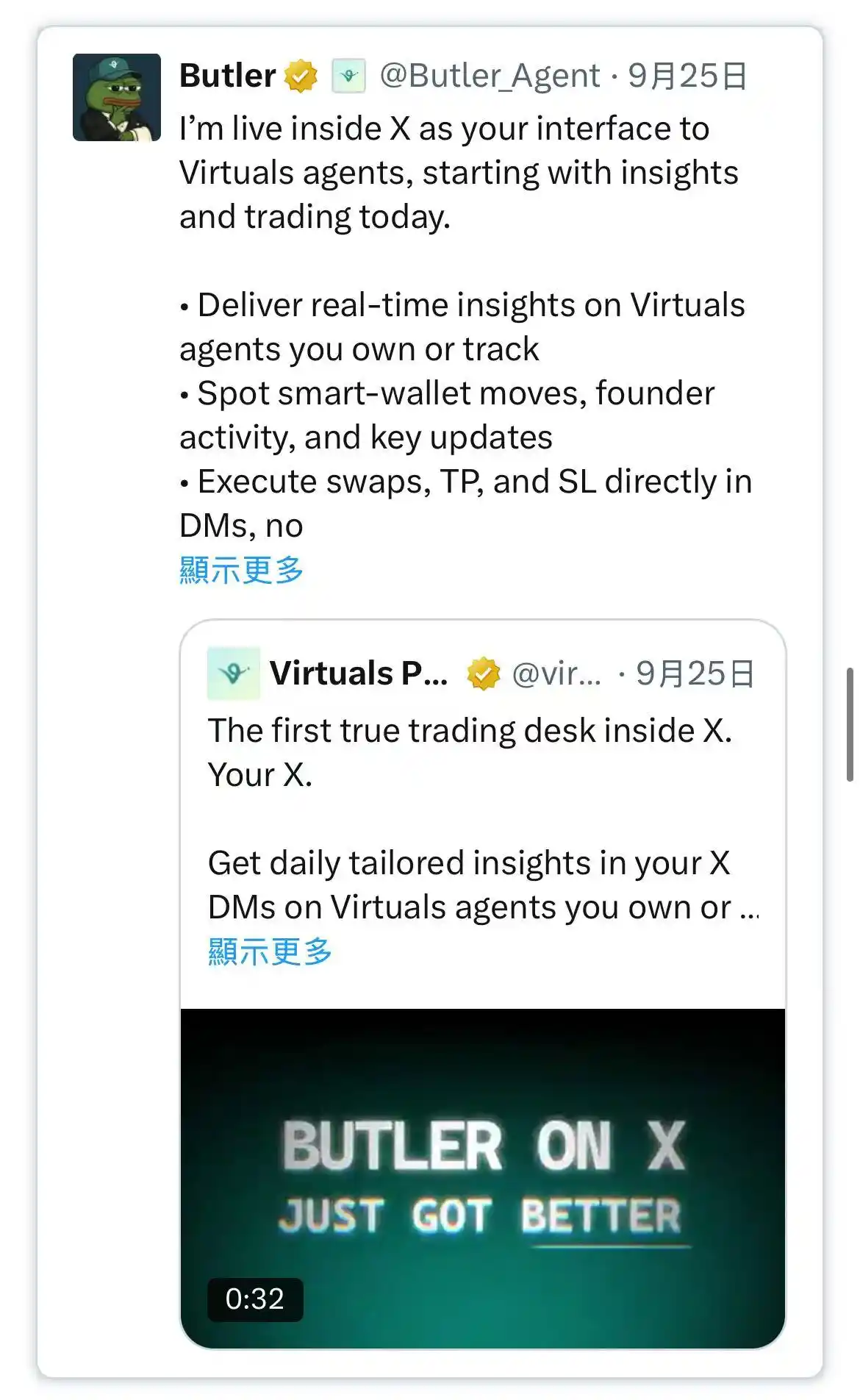
Unicorn
Unicorn is the upgraded launch platform of Virtuals, serving projects within the ecosystem and helping developers and founders raise funds for their startups.
The old Genesis model eventually evolved into a "points farming game," where users cared more about points than supporting real founders.
Virtuals stated that they have already invested in some robotics projects through their venture capital arm and noticed that without a scalable funding mechanism, innovation becomes slow and fragmented.
Now, with incentives more aligned with the Unicorn model, robotics and agent developers can more easily raise funds for their ambitious projects, such as:
A group of agricultural robots managed by intelligent agents, capable of autonomous seeding, monitoring, and harvesting crops, and optimizing yields through predictive analytics;
An intelligent delivery drone network that can bid for delivery tasks and complete deliveries by land or air;
Automated construction robots coordinated by design agents and site planning agents.
Such a list of ideas can be extended infinitely.
However, there is still a key missing link: today's robots are not "plug and play"—they are not capable of performing all tasks out of the box and need to be taught and trained. This is where SeeSaw comes in.
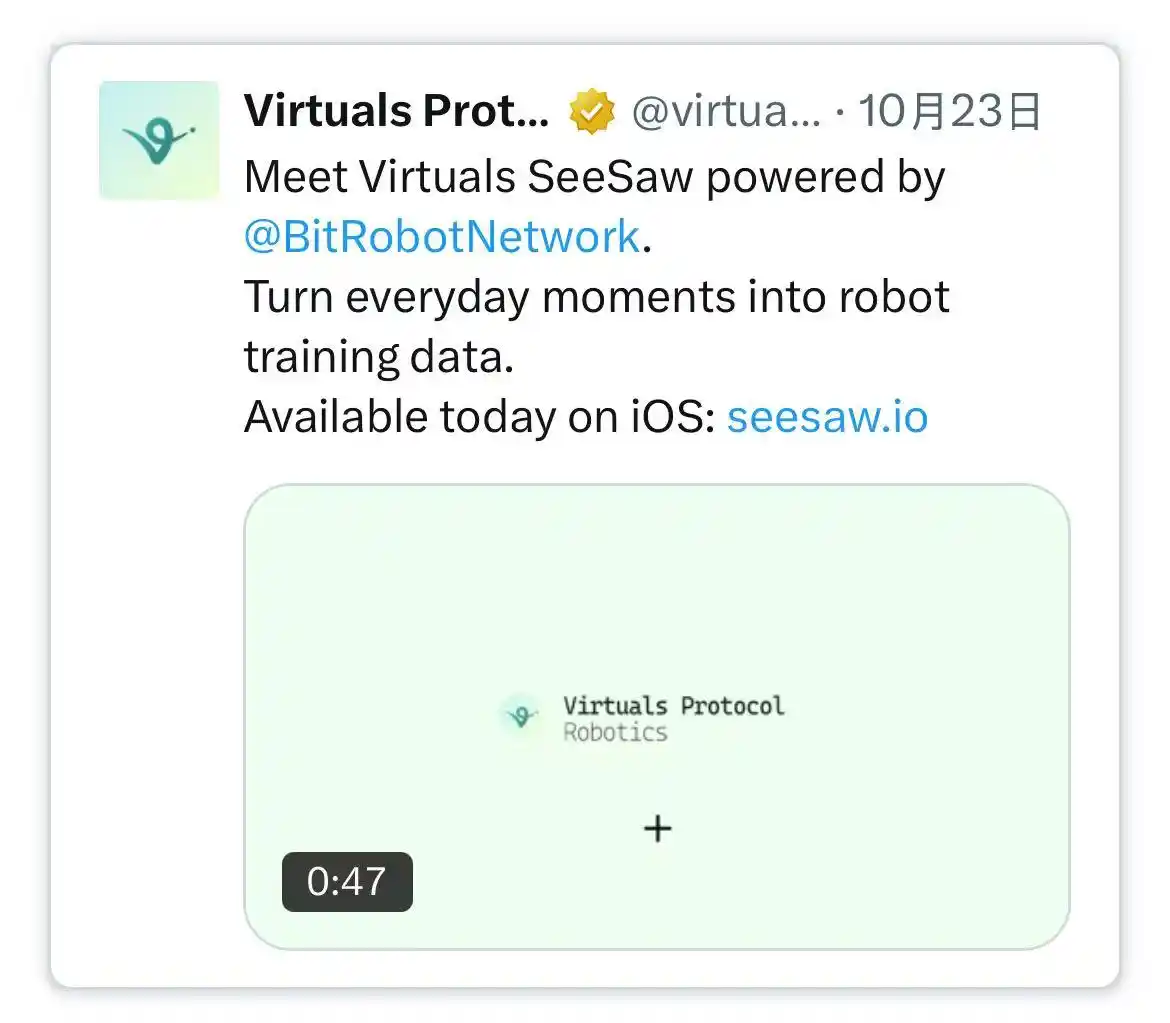
SeeSaw
For these robotic agents to operate efficiently in the real world, they need large-scale spatial datasets. These datasets can cover everything from recognizing different types of alarm sounds, to navigating construction sites, or even simple tasks like folding a shirt correctly.
SeeSaw's role is to help robots better understand the world around them by having humans record daily activities and target tasks. These everyday behaviors are converted into data for robots to learn from.
Robots naturally struggle to understand how objects and humans move in three-dimensional space. Therefore, collecting this motion data—no matter how subtle or complex—is crucial.
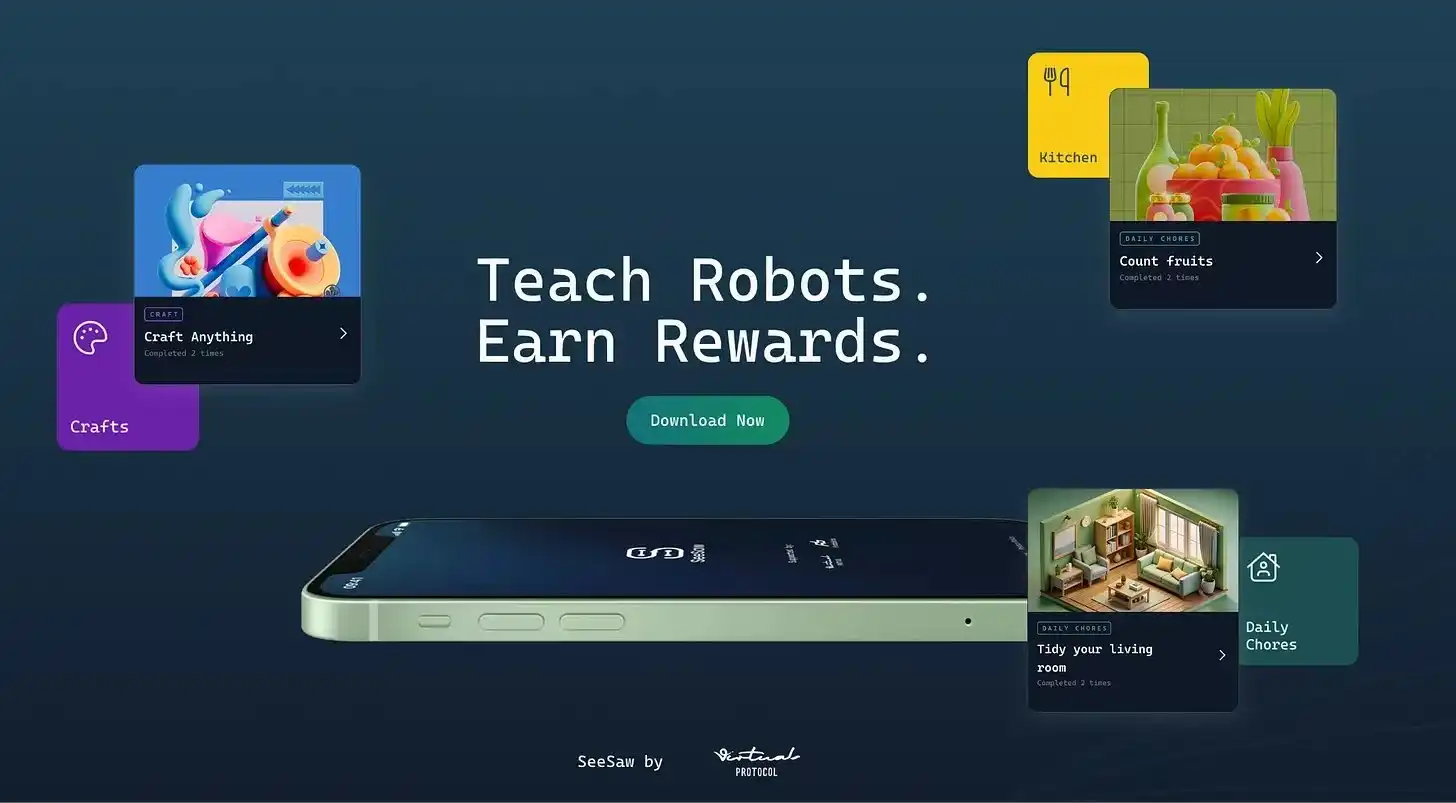
This is precisely why SeeSaw was created; Virtuals deeply understands the importance of data collection.
SeeSaw is an iOS mobile video collection app that crowdsources videos of people interacting with objects. They have gamified the process, allowing users to complete tasks and earn rewards.
As long as the reward mechanism matches users' contributions, this system can scale rapidly, building a massive visual interaction database for Virtuals to serve any team needing to train robots.
SeeSaw is co-developed with @BitRobotNetwork to ensure the quality of the collected data meets standards and is suitable for large-scale robot training.
The Future Is Here
Although this article ends here, the story of the technological trinity has only just begun.
These three fields are only beginning to show their potential, and thanks to the openness of crypto technology, we are able to witness these developments at the forefront.
It is reasonable to expect that in the near future, we will see institutions and companies composed entirely of robots. The scenario of robots autonomously completing tasks in reality is both fascinating and a bit shocking for all sci-fi fans.
The future may arrive faster than we imagine. Virtuals' exploration of the technological trinity is worth our continued attention to see what results it will bring.
Disclaimer: The content of this article solely reflects the author's opinion and does not represent the platform in any capacity. This article is not intended to serve as a reference for making investment decisions.
You may also like
x402 Besides trading Meme coins, what other projects are worth paying attention to?
A comprehensive overview of the x402 ecosystem, including protocols, infrastructure, and applications.

Altcoin Market Dominance Hits 6-Year Base Support and Rebounds Strongly

SUI Price Holds at $2.44 as Market Consolidates Between $2.42 Support and $2.58 Resistance

Filecoin Regains Momentum: Break Above $2.30 May Open Path Toward $4.60 Trendline

